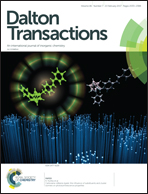Multifunctional Fe3O4/Au core/satellite nanocubes: an efficient chemical synthesis, characterization and functionalization of streptavidin protein†
Abstract
A novel and efficient chemical approach for the synthesis of Fe3O4/Au core/satellite nanocubes is reported. In a one-pot reaction, metallic Au nanodots were successfully deposited on the polyvinylpyrrolidone (PVP) functionalized Fe3O4 nanocube surface for the fabrication of a core/satellite structure (Fe3O4/Au) by the reduction of HAuCl4 using ammonia. Transmission electron microscopy and energy dispersive spectroscopy mapping revealed that small Au nanodots of about 2 nm average size decorated the surface of Fe3O4 nanocubes. X-ray diffraction data was used to confirm the formation of both the phases of a cubic inverse spinel structure for Fe3O4 and a bcc structure for Au in the core/satellite structure of Fe3O4/Au nanocubes. The magnetic properties of the seed Fe3O4 nanocubes and Fe3O4/Au core/satellite nanocubes were measured by using a superconducting quantum interference device at 300 K. For biological application purposes, the as-synthesized Fe3O4/Au core/satellite nanocubes were functionalized by cysteamine followed by successful immobilization of streptavidin protein as confirmed through the fluorescence confocal microscopy images.



 Please wait while we load your content...
Please wait while we load your content...